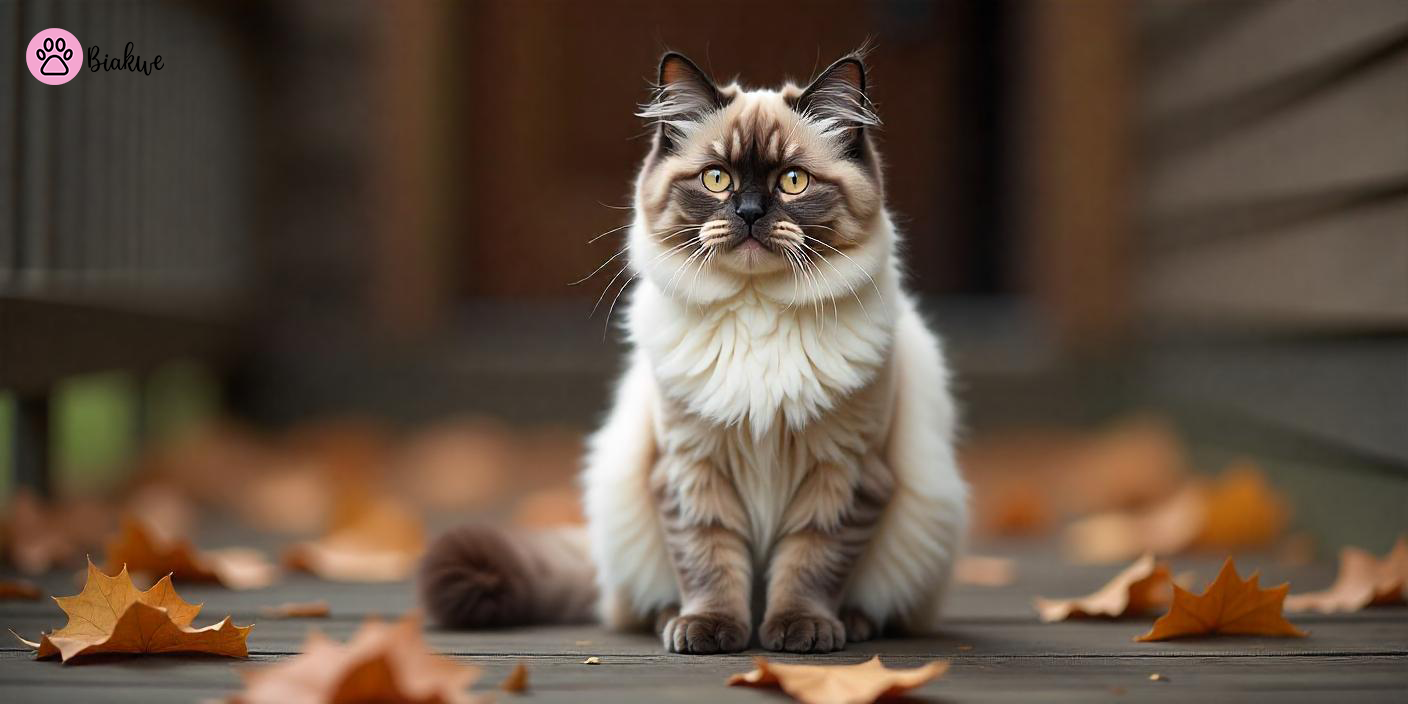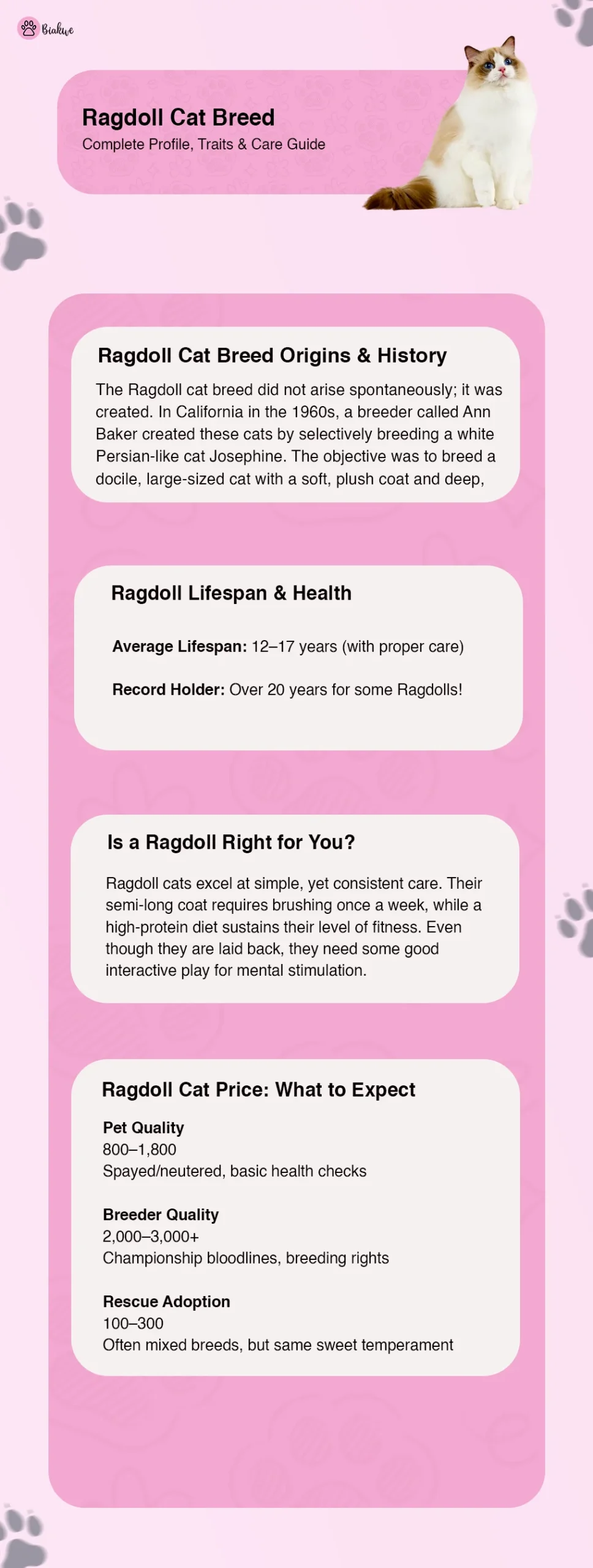Picture a cat that goes limp when you lift it up, stares at you lovingly, and has amazing blue eyes that could warm the coldest heart. That’s the Ragdoll—one of the calmest breeds renowned for its affectionate nature, plush fur, and loving attitude.
Before you rush to adopt one, let’s answer the big questions:
- Why is their body so relaxed? (Hint: It’s in their genes!)
- How much does a Ragdoll cat cost?
- Are they really as low-maintenance as people claim? (Spoiler: Mostly—but their fur does need some regular focus.)
Whether you are looking to adopt your first pet or you are a seasoned cat owner, this step-by-step guide has everything—from their astonishing origins to injury treatment.
Ragdoll Cat Breed: Origins & History

The Ragdoll cat breed did not arise spontaneously; it was created. In California in the 1960s, a breeder called Ann Baker created these cats by selectively breeding a white Persian-like cat Josephine. The objective was to breed a docile, large-sized cat with a soft, plush coat and deep, captivating blue eyes.
Key Milestones
- 1965: First official Ragdoll litter born
- 1971: Baker trademarked the breed (yes, really!)
- 1990s: Gained global popularity for their dog-like loyalty
Fun Fact: Ragdolls actually do feel pain, contrary to myth. Their floppy response is a result of extreme relaxation.
Ragdoll cats charm with their plush coats and docile nature, making them feline royalty. For lovers of majestic breeds, discover the Black Smoke Maine Coon, with its smoky fur and bold personality. Like Ragdolls, these cats captivate with their size and allure. Explore their unique beauty today!
Ragdoll Cats Traits: Personality and Looks
Ragdoll cat traits may be different from other cats. Let’s go trough these:
Ultimate Lap Cat
- Follow you like a dog: Loyal owners and accompanies them everywhere
- Calm and tolerant: Very suitable with children and other animals
- Soft spoken: Oh, so very gentle with their “fighting” (soothing chirps)
Looking Features
| Feature | Description |
| Size | Large (males surpass females in weight, averaging 10-20 pounds) |
| Coat | Long and silky with no matting tendency compared to Persians |
| Color | Seal, blue, chocolate, lilac, flame, and cream points\ |
| Eyes | Blue which is bright and clear (any other color disqualifies them as purebred) |
Why Their Eyes Are So Blue: A result of the same gene that causes their pointed coloration—similar to Siamese cats.
Ragdoll Cat Price: What to Expect
While considering the ragdoll cat price, it is important to know the pet quality, breed quality, some hidden costs and red flags. Let’s dive in.
Breaking Down Costs
| Type | Price Range | What’s Included? |
| Pet Quality | 800–1,800 | Spayed/neutered, basic health checks |
| Breeder Quality | 2,000–3,000+ | Championship bloodlines, breeding rights |
| Rescue Adoption | 100–300 | Often mixed breeds, but same sweet temperament |
Hidden Costs
- Grooming: 30-50/month for professional brushing (or invest in a slicker brush for home care)
- Health Testing: Reputable breeders test for HCM (heart disease)—ask for proof!
Red Flags
- Prices under $500 (likely backyard breeders)
- No TICA/CFA registration papers
Ragdoll Lifespan & Health
How Long Do Ragdolls Live?
- Average Lifespan: 12–17 years (with proper care)
- Record Holder: Over 20 years for some Ragdolls!
Common Health Issues
- Hypertrophic Cardiomyopathy (HCM)
Prevention: Echocardiograms ( annually–200 to 400)
- Urinary Tract Issues
Fix: Wet food diet plus plenty of water
- Obesity
Risk Factor: Weight gain due to their relaxed personality
Pro Tip: Purchase insurance early—they cover 90% of HCM treatment with Nationwide Pet.
The Ragdoll’s gentle demeanor and striking blue eyes make it a beloved companion. Curious about other vocal, elegant breeds? Dive into Siamese cat breeds, known for their sleek looks and chatty nature. Compare these affectionate felines to find the perfect pet for your home!
Care Guide for Ragdoll Cats: Every Aspect

Suitable Grooming Activities
Brush Combing (two to three times a week)
Ragdolls have a silky coat that is semi-long with Low Undercoat density (LUC). This construction makes them less prone to matting as compared to Persians. However, their fur still tangles, especially in high-friction areas:
- Neck Ruff (their ‘mane’)
- Hind Leg ‘Britches’ (the longer fur around their thighs),
- Tail Base
Bathing (if really necessary)
Ragdoll cats require minimal bathing due to their self-grooming habits and dirt-repellent fur. They only need baths if:
- They become sticky or trapped in toxic substances.
- They possess a skin disorder (e.g., allergies).
Steps for Bathing a Ragdoll
- Use a feline-concocted shampoo (one suitable for their skin pH level).
- Brush the cat first to dislodge all debris.
- Place non-slip padding to cover the base of the sink or tub.
- Shampoo should be rinsed fully—shampoo residue can be irritating.
Caution: Do not attempt baths during shedding season (spring/fall) since wet hair easily mats.

Diet Tips
High-Protein Food (40%+ Meat Content)
To maintain their strong physique, Ragdoll cats (up to 20 lbs) require a high protein content in their diet. Look for:
Specific meat sources such as “chicken” or “salmon” instead of generic “meat by-products” Protein sources with little carbs such as corn, wheat, and soy fillers.
Best Options are:
- Wet food (high moisture content supports urinary tract health)
- Freeze dried raw diets (dietary convenience of fresh alternatives to raw).
Portion Control
- Adults: Dry food ¼–½ cup + Wet food 3 oz twice daily
- Kittens: Free feed from kitten food up to one year.
Exercise & Play
Interactive Toys
While Ragdolls may appear calm, they need mental exercises on a daily basis. To optimize:
- Chase feather wands (simulates prey and activates the chase instinct).
- Puzzle feeders (hinder rapid eating and add mental challenge).
- Crinkle balls (Ragdolls enjoy lugging these balls around).
Playtime Tips: 10–15 minutes of play two times a day. Though they will tire out, they will appreciate the engaging play sessions.
Final Thoughts: Is a Ragdoll Right for You?
“Owning a Ragdoll means never having an empty lap or a quiet moment—just endless love wrapped in silky fur.”
Ragdoll cats excel at simple, yet consistent care. Their semi-long coat requires brushing once a week, while a high-protein diet sustains their level of fitness. Even though they are laid back, they need some good interactive play for mental stimulation.
A Ragdoll lifespan is 12-17 years so with proper care should ensure a Ragdoll’s health and affability. Their gentle attitude makes them great companions while their loyalty is dog-like. Meeting basic requirements grooming, nutrition, play makes this breed loving and remarkable over the years.
